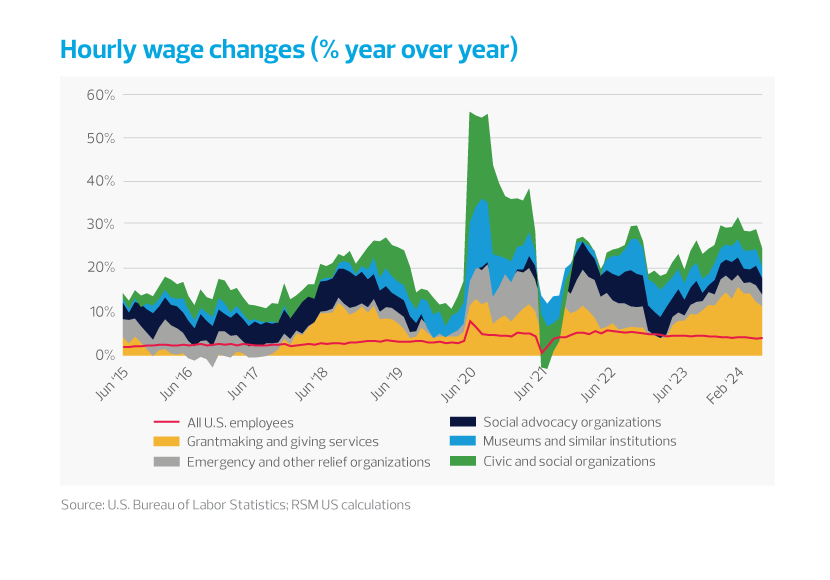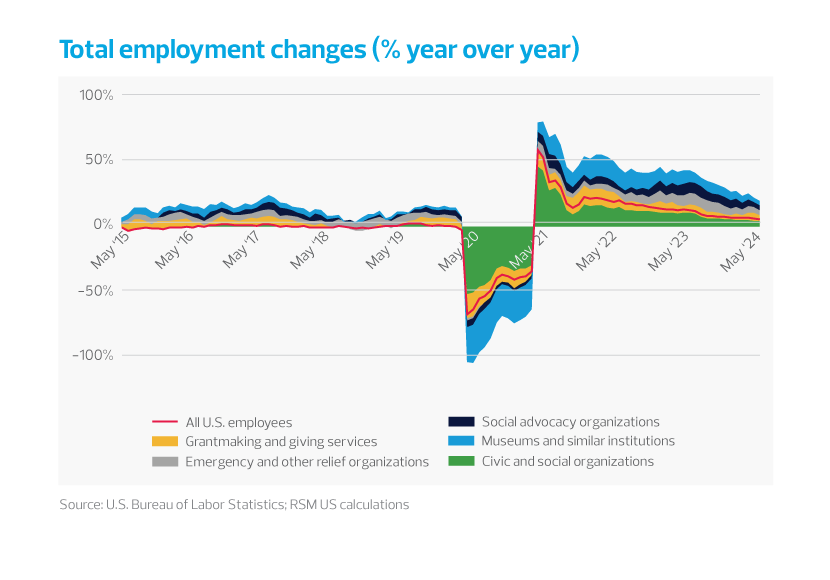Nonprofits are still hiring lots of people despite increasing labor costs.
Key takeaways
But nonprofits still have significant staff vacancies.
Organizations need to enhance the quality and productivity of their current workforce.
Evaluating nonprofit workforce data is both a critical task for the industry and a frustratingly difficult one. The Bureau of Labor Statistics (BLS), which tracks national labor data in incredible detail, has not aggregated nonprofit data since 2017. Fortunately, some nonprofit advocacy groups are rallying to address this shortcoming. From both anecdotal and survey data, we know that nonprofits have struggled to fill job vacancies and retain staff, especially since the COVID-19 pandemic.
Absent comprehensive data on nonprofits, we have analyzed national BLS data through a nonprofit lens to determine proxies for the nonprofit sector. Specifically, we drilled down on industries (and sub-industries or sectors) in which more than half of the industry’s workforce was employed in 501(c)(3) organizations, according to the BLS’s 2017 data. We have omitted education- and health-related nonprofits because they largely operate in separate ecosystems.
The result may be surprising and contrary to much of the public narrative: the rate of increase in pay for nonprofit workers, cumulatively, is indistinguishable from the overall labor force. Pay increases in some sectors did not keep up with the overall labor force from roughly mid-2021 to early 2023, but since then, pay increases are largely on par with national averages. This is consistent with the long-term trend outside of the pandemic years.

This does not indicate excessive increases in wages and salaries within the nonprofit industry. Rather, nonprofits’ experiences with labor costs simply mirror the overall increase of labor costs throughout the U.S. economy.
Still, this overall wage increase of roughly 5% per year since 2020 exceeds recent historical norms. The BLS finds that total labor cost per hour increased 25% between December 2018 and December 2023. Though nonprofit budgets are feeling the weight of increased labor costs, so is everyone else.
Even though the rate of per-hour cost change does not significantly vary from the overall labor force, nonprofits have proportionally added more staff to their payrolls than the national average. While mostly in line with national averages before the pandemic, nonprofits have consistently added a higher percentage of employees since mid-2021.
So how do we reconcile BLS data indicating robust hiring with surveys that show significant hiring difficulties? The likely conclusion is that nonprofits are experiencing meaningful growth and financial viability, which requires them to seek more staff than they are readily able to hire.

Though the labor market has recently begun to soften, we do not anticipate a sudden drop in hiring or increase in unemployment. Rather, we project a slow but steady shift over the next several quarters toward a more normalized labor market, as opposed to the excessively tight one that we’ve experienced over the past few years.
For nonprofits that struggle with staff vacancies or tight personnel budgets, this means minimal relief over the intermediate term. Nonprofit leaders need to come to terms with these lasting workforce challenges. They need to invest financial resources in the organization’s people, processes and technology to remain effective in their work.
Fortunately, this need to alleviate labor costs and shortages arrives at a time of opportunity. In particular, many nonprofits increased financial reserves over the past few years. Combined with the increased accessibility of technology, investing in labor-saving tech and practices can not only alleviate workforce challenges, but usher an organization into a new digital era.
Here are five suggestions for nonprofits to get started (or continue) on this journey:
Invest in cloud-based software that will create efficiencies throughout the organization, not just in the back office.
Collect and analyze data on program outcomes and costs to calculate missional return on investment. Consider changes or eliminations to your services and programs if they are underperforming.
Discard outdated salary assumptions. You compete in a broad labor market and need to attract top talent. Consider the benefits of hiring and retaining the right people and build your organization’s budget around that.
Consider outsourcing activities that don’t relate to your mission, like IT and accounting; this would allow you to focus more on your core programs while taking advantage of functional and technical expertise in these areas.
Make the case to your current funders for both one-time investments (as in a software implementation) and ongoing operations (to sustain higher salaries).
It is important for nonprofits, as with any organization, to take a data-centric view of their operating environment. In the case of the nonprofit workforce, the data clearly shows an industry in growth mode: wages are keeping up with the overall economy and nonprofits are hiring lots of people but still have significant staff vacancies. The time is right for nonprofits to focus on enhancing the quality and productivity of their current workforce rather than continuously expanding their payrolls.

